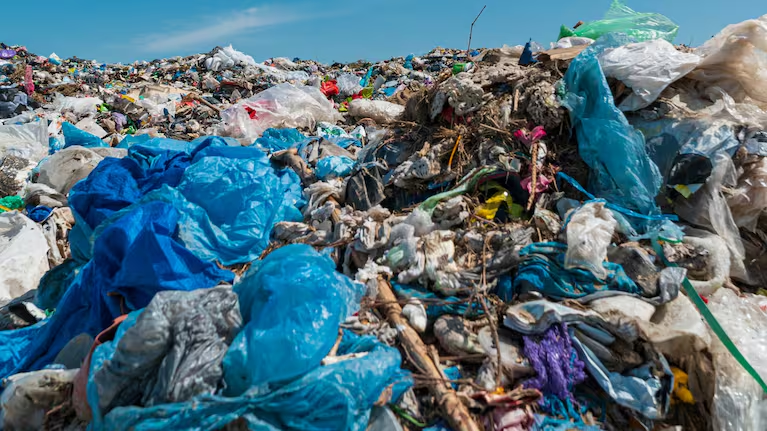In the Mbale district of Uganda, which is well-known for producing arabica coffee, a problem with plastic bags called buveera is spreading outside of the city.
In Kampala, the capital, where Biveera are ingrained in daily life, the issue has long plagued the landscape. They choke streams and appear in layers of dirt roads that have been excavated. However, they are now also found in isolated farming regions. The large plastic bags used in nurseries to grow coffee seeds are among the trash.
Wilson Watira, the head of a cultural body for the Bamasaba people who grow coffee, said some farmers are protesting. “Those farmers who are aware of the impact of buveera on the land are worried,” he stated.
Plastics end up in agricultural areas all over the world. For some farmers, agricultural plastic—which is already essential for many crops—becomes even more inevitable due to climate change. In the meantime, studies are demonstrating that tiny microplastics change ecosystems and find their way into human bodies. Consumers, farmers, and scientists are all concerned about the impact on human health, and many are looking for answers. However, even with the best-laid plans for recycling and reuse, industry experts say it is hard to know where plastic ends up or to get rid of it entirely.
Soils are one of the primary receivers of agricultural plastics, according to a 2021 study on plastics in agriculture published by the United Nations Food and Agriculture Organization. According to some research, soils are more contaminated by microplastics than the oceans.
Speaking to the public about microplastics, Sarah Zack, an Illinois-Indiana Sea Grant Great Lakes Contaminant Specialist, stated, “These things are being released at such a huge, huge scale that it is going to require major engineering solutions.”
Why researchers want to study plastics in farm fields
Plastic microparticles from clothing, drugs, and cosmetics can occasionally be found in fertilizer made from biosolids, which are solid wastewater treatment byproducts. Depending on the treatment method, biosolids can also be hazardous and odorous to the local population. Certain seeds are wrapped in plastic polymers that are intended to break down at the ideal moment of the growing season, or they can be spread across fields to retain moisture or placed in pesticide containers.
However, just slightly more than 3% of all plastics used worldwide come from the agriculture sector alone. Single-use plastic food and drink containers make up around 40% of all plastics used in packaging.
The largest microplastics are roughly the size of a pencil eraser, while the National Oceanic and Atmospheric Administration defines microplastics as those that are less than five millimeters long. Some are considerably smaller.
Research has already demonstrated that microplastics can be ingested by humans or animals after being absorbed by plankton in the water or plants on land. The long-term implications of the plastic discovered in human organs are currently being investigated by scientists. According to preliminary research, there may be connections to a number of illnesses, such as heart disease and certain types of cancer.
The FAO’s environment lead, Lev Neretin, stated that the evidence regarding the land-based food chain “is certainly raising alarm” despite “significant research gaps.” The FAO is also working on another technical report that will delve deeper into the issue of microplastic pollution in crops and soils.
Microplastic pollution can even affect plants’ capacity to photosynthesize, which is the process by which they convert solar light into energy, according to a study published this month in the Proceedings of the National Academy of Sciences. Fei Dang, one of the study’s authors, stated that while it does not “justify excessive concern,” it does “underscore food security risks that necessitate scientific attention.”
Climate change making matters worse
In the previous 30 years, the use of plastics has increased fourfold. Plastic is all around us. Additionally, the majority of plastic produced worldwide is burned, polluted, or ends up in landfills. The recycling rate for plastics is less than 10%.
Simultaneously, some farmers are depending more on plastics to protect their crops from harsh weather conditions. They are attempting to regulate the conditions for their crops by employing tarps, hoop houses, and other technologies. Additionally, in order to protect themselves from unpredictable weather and increasingly widespread pest problems, they are relying more on chemicals like fertilizers and pesticides.
Global warming is causing us to run out of fertile land for grain production. But we need those other crops. The need for agricultural chemicals is increasing as a result, according to Ole Rosgaard, president and CEO of Greif, a company that produces packaging for industrial agriculture products including pesticides and other chemicals.
Extreme weather brought on by climate change also affects how agricultural plastics break down and travel. The sun’s rays can destroy materials over time. Furthermore, more frequent and intense rainfall events may cause more plastic particles to wind up in fields and then waterways in some areas, according to Maryam Salehi, an associate professor of civil and environmental engineering at the University of Missouri.
Can agriculture escape the plastic problem?
This past winter, leaders from around the world gathered in South Korea to produce the first legally binding global treaty on plastics pollution. They didn’t reach an agreement, but the negotiations are scheduled to resume in August.
A temporary, voluntary code of conduct on the sustainable management of plastics in agriculture was created by the FAO, according to Neretin. However, most nations lack a compelling reason to abide by it in the absence of a formal treaty.
He added that international cooperation “takes time, but the problem does not disappear,” and that “the mood is certainly not cheery, that is for sure.”
Companies bear a large portion of the burden in the absence of governmental will.
Rosgaard, of Greif, said that his company has worked to make their products recyclable, and that farmers have incentives to return them because they can get paid in exchange. But he added it’s sometimes hard to prevent people from just burning the plastic or letting it end up in fields or waterways.
“We just don’t know where they end up all the time,” he said.
Some people wish to prevent plastic and microplastic trash from entering ecosystems. Ph.D. candidate Boluwatife Olubusoye of the University of Mississippi is investigating the potential of biochar—remains of organic materials and plant waste burned under regulated conditions—to filter out microplastics that enter streams from agriculture fields. His initial trials have yielded encouraging results.
He stated that he was inspired by the perception that, particularly in underdeveloped nations, there was “never any timely solution in terms of plastic waste” that ended up in fields in the first place.
It can be difficult for farmers to take action, even if they are concerned about plastics in soil. According to Jacob Ogola, an independent agronomist in Uganda, nursery bed owners there utilize inexpensive plastic bags to germinate seeds because they cannot afford appropriate seedling trays.
The least able to lessen the amount of inexpensive plastic garbage in soils are farmers who are most affected by climate change. This irritates Innocent Piloya, an agroecology businesswoman who operates Ribbo Coffee, a coffee growing enterprise in rural Uganda.






